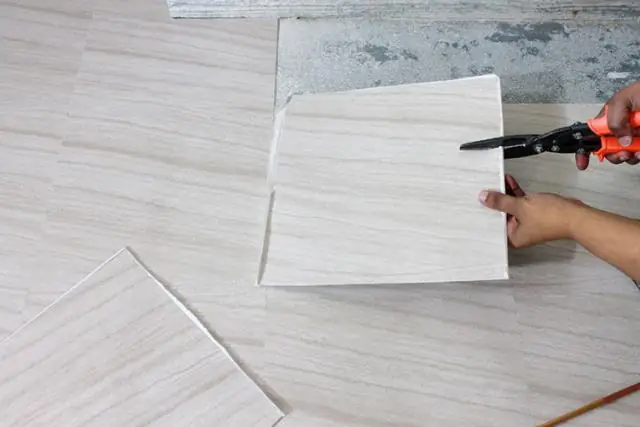
Table of contents:
- Author Bailey Albertson [email protected].
- Public 2024-01-17 22:26.
- Last modified 2025-06-01 07:32.
We clean and cut carp at home

Cleaning and cutting carp is a simple process, albeit unpleasant. But after you turn the “fresh catch” into a culinary masterpiece that will delight the family, you will no longer be bothered by the presence of scales, blood and offal in the process of working on a dish of very healthy and incredibly tasty fish.
Content
-
1 Features and value of carp
- 1.1 Carp species - gallery
- 1.2 Tips for choosing quality fish
-
2 Cleaning and cutting carp
- 2.1 What you need for work
-
2.2 Step by step instructions for cleaning, gutting, cutting carp
2.2.1 How to peel whole carp - gallery
- 2.3 How to cut fish into fillets
- 2.4 The art of carp cutting - video
Features and value of carp
Carp is an artificially bred species of fish, the progenitor of which is the carp. The word "carp" comes from the Greek language and is translated as fruit. And for good reason: one female gives up to 1.5 million eggs. The first to breed domesticated carp were the Chinese. Historians believe that this fish began to be used for food as early as 1000 BC. e. Carp dishes have become a favorite treat for Chinese emperors. Later, fish began to be raised in other countries of Asia and Europe.
Carp meat has tremendous benefits for the body. It is very delicate and sweetish in taste. The fat content of the muscle tissue of fish is lower than that of lean beef, which is important for people on a low-fat diet, as well as for children and athletes. Carp are a source of many important nutrients, proteins and omega-3 fatty acids. These unsaturated acids have a positive effect on heart function and help prevent cardiovascular disease. Another feature of carp is its easy digestibility, due to the special structure of muscle fibers.
It takes three or four years to grow carp in artificial reservoirs. Three-year-olds weigh about 2 kg, and four-year-olds weigh more than 2.5 kg.

Carp is a domesticated form of carp
Carp varieties - gallery
-

Naked carp -
Naked carp have absolutely no scales
-

Mirror carp - A feature of the mirror carp is the arrangement of large shiny scales along the back
-

Common scaly carp - The body of a common carp is completely covered with medium-sized scales
Tips for choosing quality fish
- Fresh carp are easier to clean. If you buy fish from a store or market, try to get it from the aquarium. You can kill it with a strong blow to the head at a point located slightly above eye level, or simply by cutting off the head (if you are not going to bake the whole carp). There is also a more humane way of killing fish - put it in the freezer for an hour and it will fall asleep.
- If you do not have the opportunity to buy live fish, it is better to choose fresh chilled, since frozen fish loses a large amount of minerals during thawing. When buying fresh fish, go for a headless specimen. This is the only way you can be sure of its freshness.
- Before buying, look the fish in the eyes: fresh ones should be bright, slightly damp and bulging.
- Be sure to check out the gills and opt for a specimen with clean, bright, and red gills.
- The body of fresh fish is quite elastic, without white bloom and dried crusts, and the tail should hang freely from the palm.
- When buying frozen carp, look out for the icing. If the fish has been properly frozen and stored under all necessary conditions, the glaze on it should be even, without the presence of cracks. If the carp was frozen by dry freezing, then the carcass should be smooth and firm, without the presence of ice.
It is best to thaw frozen fish in room temperature water. To reduce the loss of minerals during thawing, add table salt to the water (7-10 g per 1 liter of water).

The eyes of fresh fish should be protruding and slightly moist, and the carcass should be firm, without white bloom and dried crusts
Cleaning and cutting carp
Currently, a huge number of recipes for cooking carp have been invented. It is baked with a garnish of vegetables, potatoes and cereals, as well as boiled with spices, stuffed in various ways and simply fried in vegetable oil until crispy. On the shelves of shops you can find gutted frozen fish, fillets and ready-made semi-finished products. But you get the most benefit from fresh or live carp. Do not be afraid of the upcoming hassle of cutting fish. Having mastered a few simple rules, you can easily turn a live carp into a culinary masterpiece.
Common and mirror carp are most often found on sale. The latter is a little easier to clean, due to the fact that its scales are large and not very tightly pressed against each other. You will have to tinker with ordinary carp longer.
What you need to work
For proper and easy cleaning and cutting of fish you will need tools:
- a sharp knife for cutting fish;
- fish scissors;
- fish scraper, you can use a spoon.

To facilitate the process of cleaning and cutting carp, purchase the necessary tools: a - a sharp knife, b - scissors, c - scrapers
You also need to prepare:
- a plastic bag or bucket for bones and other rubbish;
- thick paper or newspaper;
- work gloves.
Step-by-step instructions for cleaning, gutting, carp cutting
-
Cover the table with heavy paper or newspaper. The paper will absorb the liquid that the fish will release during cutting and prevent contamination of the workplace. Some housewives prefer to clean and cut the fish right in the sink, having previously closed the drain with a special silicone or metal mesh.

Carp before cutting Some housewives clean and cut fish in the sink
-
Wear work gloves.

Cleaning fish in the sink with gloves Wear work gloves to keep the fish from slipping out of your hands.
- If you don't need the fins to cook the dish, use a kitchen scissors to cut them off. This will help avoid painful punctures while working.
-
Press the fish in the area of the head or tail and with a scraper, and if it is absent with a knife or spoon, remove the scales first diagonally from the abdomen to the back, and only then from the tail to the head. The movements should be short, try to get under the scales, pushing them up. Don't worry if some scales remain on the fish. It is, of course, tasteless, but it will not harm your health either.

Cleaning carp from scales Remove the scales with a scraper
- To remove the entire skin, from the side of the belly, cut it around the gills to the vertebral bone, break the bone upwards. Carefully remove the giblets from the belly through the incision. Then run the edge of the knife under the skin and begin to remove it with a stocking, separating the skin from the carcass with your fingers. When you get to the fins, trim the inside out with sharp scissors. Before reaching 1.5-2 cm to the tail fin, trim the tail from the inside.
-
If skinning is not required, make a shallow cut at the bottom of the carcass near the fin and cut along the belly, stopping at the base of the head. Take out the insides, being careful not to crush the gallbladder, otherwise the fish meat will become bitter. If you failed to keep the gallbladder intact, and bile spilled onto the carcass, immediately rub it inside with salt, and then rinse with cool water.

Cleaning carp from entrails Slice the carcass along the belly and remove the entrails
-
Remove the brown film inside the abdomen and, depending on the method of preparation of the future dish, remove or leave the head. This part of the carp is considered very tasty and should be left aside. If you leave the head, then remove the gills and eyes from it.

Carp head removal Remove the head or pull the gills out of it
- If you want to get rid of numerous small bones, then remove the dorsal fin by pulling it from the tail to the head of the fish.
- Rinse the fish thoroughly with running cool water inside and out.
How to peel whole carp - gallery
-

Carp carcass with a transverse cut along the head - From the side of the abdomen, a transverse incision is made along the head to the vertebral bone
-

Carp carcass with a cut under the skin - After the incision is made under the skin, you can start removing the skin with a stocking
-

Carp carcass with skin removed - The carp head must remain on the skin
-

Carp skin removed from the whole carcass, including the head - To remove the entire skin, the tail and fins of the carp are cut with a sharp knife from the inside.
How to cut fish into fillets
When cutting carp into fillets, you need to separate the meat from its inedible parts: skin, spine, bones. To do this, it is not necessary to pre-gut and clean the fish from the scales.
-
Use a sharp fillet knife to cut along the fish's gills to the spine, but do not cut through.

Fish with a notch along the gills To cut carp into fillets, you need to make an incision along the gills of the fish
-
Using the sharp end of a knife, cut from the side of the dorsal fin along the vertebra up to the head. Lead him until he connects with the original.

Fish with a notch on the side of the dorsal fin An incision from the side of the dorsal fin is made before the incision along the gills.
-
Cut the fish carcass in the tail with a knife. When you reach the anus, pierce the carcass through and cut the loin off the tail.

Fish carcass with a slit in the tail In the tail part, the carp carp must be cut with a knife
-
From the side of the dorsal fin, lift the fillet, and trying to bypass the ribs of the fish, separate the meat from them. Use a sharp fillet knife, and then the procedure will not seem tedious.

Fish fillets are removed from the ribs When separating the meat, the ribs do not need to be cut: they must remain on the ridge.
-
When you get to the belly, cut off the top of the fillet. You should end up with two pieces of fish. One piece will be deboned, the other still needs to be processed. Turn the fish over to the other side and remove the fillets from the second part of the fish.

Fillet removed from part of fish Fillets must be removed first on one side, then on the other
-
Place the fillets skin side down on a cutting board, press down with your hand and cut in the middle to the skin.

Carp fillet with skin We make an incision in the middle of the fish to the skin to remove it
-
To remove the fillet, run along the tail with a knife and separate it first from one half, and then from the other. The same will need to be done with the second half of the carcass.

Fish fillet After separating the carp meat from the bones, you need to remove the skin
- All leftovers after filleting carp will come in handy when you cook fish soup. Do not forget to remove the offal and thoroughly wash the fish under running water.
The art of carp cutting - video
Now you can easily diversify your family's diet with carp dishes. The described instructions will help you to quickly and correctly clean and cut up very tasty and rich in nutrients.
Recommended:
How To Clean A Sturgeon Correctly And Cut It At Home + Video

Features of processing sturgeon carcasses: whether it is necessary to clean and how to cut it properly, fresh or frozen. Simple step-by-step instructions with photos and videos
How To Clean And Cut Fish Correctly: Methods Of Fillet Processing, What To Do To Prevent Scales From Flying, How To Gut And Other Recommendations + Video

How to clean fish properly. How can you cut it. Processing methods for different varieties. Step by step instructions. Photo and video
How To Clean Peanuts From Husks And Shells, How To Store Them At Home + Video And Photos

How to properly store peanuts at home and how to quickly peel them from husks and shells using simple methods
How To Peel Burbot And Cut It At Home + Video

How to properly clean and cut burbot at home. Features of independent work with fish and recommendations of professionals
Recipe For Making Silver Carp Herring At Home + Video

Different options for cooking silver carp herring. Cooking features, ingredients
